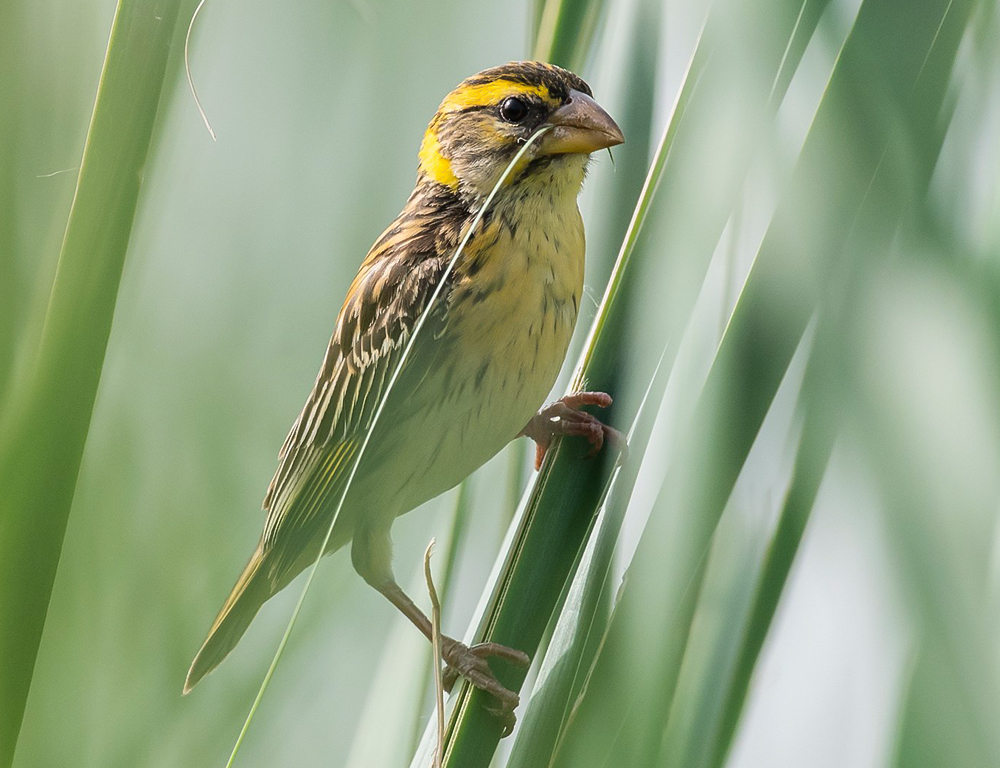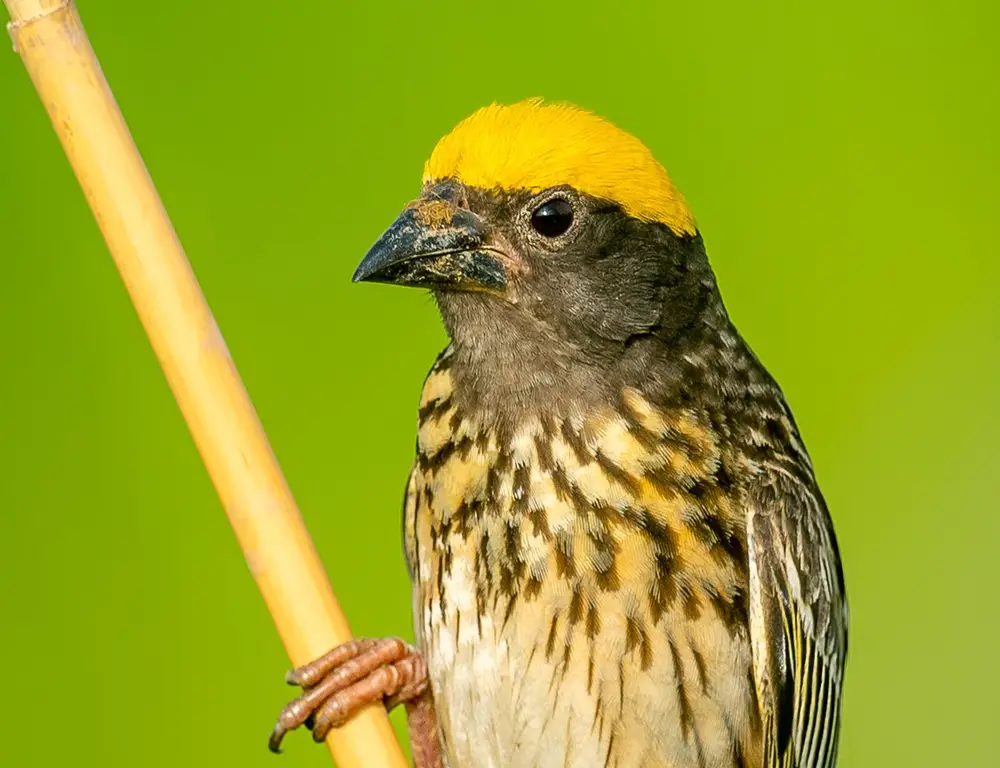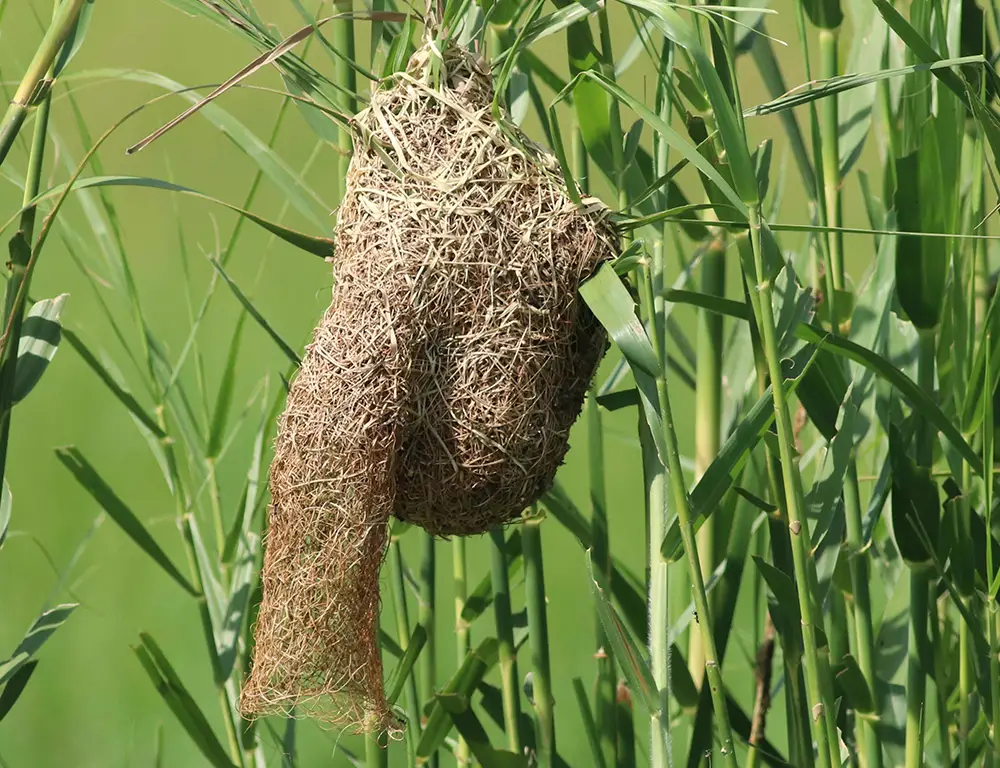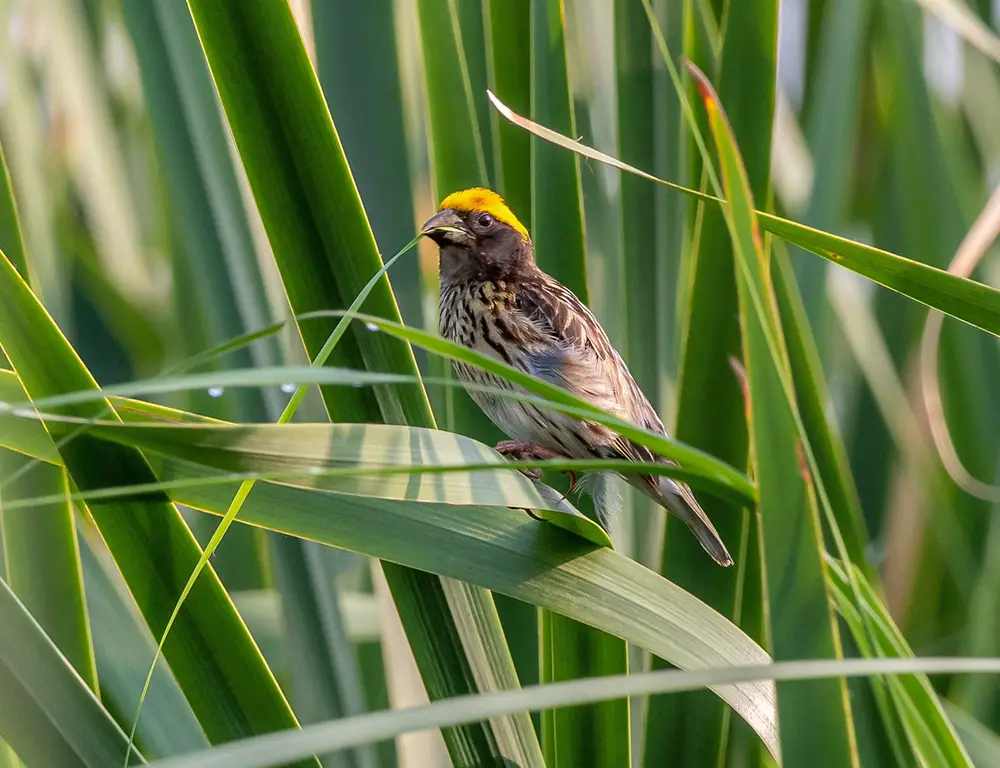I’ve always been captivated by the wonders of the natural world, and recently, one species has piqued my interest: the Streaked Weaver (Ploceus manyar). This bird offers a fascinating insight into avian behavior with its distinctive plumage and unique nesting habits.
Inhabiting Southeast Asia’s wetlands and agricultural fields, Streaked Weavers stand out with their striking yellow-green coloration and dark stripes along their backs.
However, their remarkable skill in weaving intricate nests from grasses and palm leaves truly sets them apart.
These nests showcase architectural marvels and play a crucial role in the birds’ social dynamics. Join me as we explore the captivating world of the Streaked Weaver, uncovering the secrets of nature through the study of this remarkable species.

Physical Characteristics of the Streaked Weaver
The Streaked Weaver (Ploceus manyar) has several distinctive physical characteristics:
Plumage
Streaked Weavers have a striking plumage characterized by a combination of brownish-yellow and olive-green colors. The upperparts are typically a rich brown, blending well with their habitat, while the underparts are bright yellow.
During the breeding season, males may exhibit darker streaks and patches of black on their heads and faces, particularly around the eyes, while females and juveniles have plainer plumage without these markings.
Size
Streaked Weavers are small birds, measuring around 12-15 centimeters (4.7-5.9 inches) in length from beak to tail. They have a compact and slender build, with relatively short wings and tails compared to their body size.
Weight
On average, Streaked Weavers weigh between 18 and 25 grams (0.63 and 0.88 ounces). They are lightweight birds with delicate bone structures, which allows them to maneuver easily through their habitat.
Facial Features

Males of the species may have distinctive black masks or patches of black feathers across their eyes, giving them a masked appearance. These facial markings are absent in females and juveniles, with plain brown heads without significant patterning.
Beak
Streaked Weavers have tiny, conical beaks suited for their granivorous diet, allowing them to crack open seeds and grains efficiently. Their beaks are typically dark in color, which contrasts with the lighter plumage around their face.
Legs and Feet
These birds have relatively short, stout legs equipped with strong claws, which aid them in gripping reeds and grasses as they construct their intricate nests. Their feet are adapted for perching and grasping, enabling them to move with agility within their habitat.
Habitat of the Streaked Weaver
The Streaked Weaver (Ploceus manyar) is primarily found in South and Southeast Asian wetland habitats. Here are some details about its habitat:
Geographic Range
Streaked Weavers are native to various South and Southeast Asian countries. This includes regions such as India, Sri Lanka, Nepal, Bangladesh, Myanmar, Thailand, and parts of Indonesia.
Wetland Habitats
These birds are commonly associated with wetland ecosystems, including areas such as:
- Marshes: Streaked Weavers can be found in marshy areas with tall grasses and reeds, which provide suitable nesting sites and foraging grounds.
- Paddy Fields: They are often observed in agricultural landscapes, particularly rice paddies and flooded fields, where they feed on seeds and insects.
- Riverbanks and Lakeshores: Streaked Weavers may also inhabit areas near rivers, streams, lakes, and ponds, where they can find food and nesting materials.
Vegetation
Streaked Weavers prefer habitats with dense vegetation, particularly tall grasses, sedges, and reeds. These provide them ample cover for nesting, roosting, and foraging opportunities.
Human-modified Landscapes
While Streaked Weavers are primarily associated with natural wetland habitats, they can also adapt to human-modified landscapes. They may be found in agricultural areas, urban parks, and gardens where suitable habitat conditions exist.
Nesting Sites

Streaked Weavers build intricate nests suspended from tall reeds or grass stems over water bodies, such as marshes or rice paddies. These nesting sites protect from ground-based predators, flooding, and easy access to food sources.
Behavior of Streaked Weavers
The Streaked Weaver (Ploceus manyar) behavior is characterized by feeding habits, nesting behavior, and social interactions.
Here are some key aspects of their behavior:
Feeding Habits
Streaked Weavers are primarily granivorous, meaning they mainly feed on seeds and grains. They forage for seeds from various grass species found in their wetland habitats. During the breeding season, they may also consume insects to provide protein-rich food for their young.
Streaked Weavers often employ a feeding technique called “gleaning,” where they pick off insects or seeds from leaves while hovering in mid-air.
Nesting Behavior
Nest building is a significant aspect of the Streaked Weaver’s behavior, particularly during the breeding season. Male Streaked Weavers are responsible for constructing intricate nests of woven grasses and palm leaves.
After inspecting them, I noticed they build several nests within their territory, and females choose one for egg-laying. The nests have a unique bottle-like shape with an entrance tunnel leading into the main chamber, protecting them from predators and harsh weather conditions.
Social Structure
Streaked Weavers exhibit cooperative breeding behavior and often live in large colonies comprising several hundred pairs. Within these colonies, multiple males may assist females in nest building and caring for the young.
They also engage in mixed-species feeding flocks, where they forage alongside other weaver species during non-breeding periods. This social structure promotes cooperation and mutual protection within the colony.
Communication
Like many bird species, Streaked Weavers use vocalizations and body language to communicate with each other. They have a variety of calls used for mate attraction, territory defense, and warning signals.
To attract females, males may perform courtship displays, such as fluttering flights and song performances.
Territorial Behavior
Male Streaked Weavers defend territories during the breeding season, often using vocalizations and aggressive displays to deter intruders.
Territories typically include suitable nesting sites and foraging areas, and males invest considerable effort in maintaining and defending them.
Conservation Status of the Streaked Weaver

Some of you might be wondering about the current state of Streaked Weavers in our world today. Well, let’s dive into that. According to the International Union for Conservation of Nature (IUCN), these intriguing birds are listed as “least concern”.
This designation means they’re not currently facing any immediate threats to their survival.
However, don’t let this status fool you into complacency. Even though they’re not on the brink of extinction like some species, it doesn’t mean we can sit back and relax. The truth is that Streaked Weavers still face challenges that could threaten their populations in the future.
One major factor that poses a risk to these creatures is habitat loss. With rapid urbanization and deforestation in many parts of Asia where they call home, Streaked Weavers have seen significant reductions in suitable nesting and foraging areas.
Here’s a little snapshot:
| Year | Estimated Habitat Loss (%) |
|---|---|
| 2000 | 15 |
| 2010 | 25 |
| 2020 | 35 |
This table shows an alarming trend of increasing habitat loss over time.
Moreover, pollution serves as another challenge for these birds. Exposure to pesticides used in farming can lead to health issues among weaver populations or even cause death.
- Pesticide exposure
- Reduced food supply
- Nest destruction
These are just a few examples of obstacles faced by Streaked Weavers due to human activities.
While the current conservation status may seem reassuring at first glance, it’s crucial not to overlook the ongoing threats faced by these fascinating creatures. Remembering this allows us all to play our part in ensuring their continued survival – because every species matters!
Conclusion
Exploration of the Streaked Weaver deepened my appreciation for this remarkable bird species. From their striking plumage to their intricate nesting habits, they embody resilience and adaptability across diverse environments.
Despite our growing understanding, there remain gaps in knowledge, underscoring the importance of ongoing research. The male’s role in nest construction, changing plumage, and ability to thrive in various conditions highlight their intriguing nature.
As we continue to study and uncover more about the Streaked Weaver, we contribute to a greater understanding of avian biology and conservation.
Through continued exploration, we can shed light on the complexities of nature and further appreciate the marvels of the Streaked Weaver and its place within it.